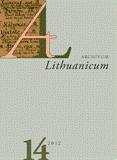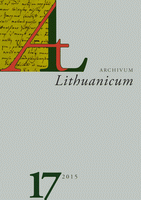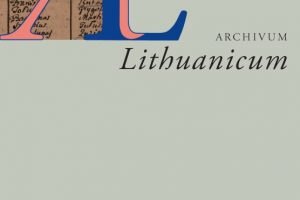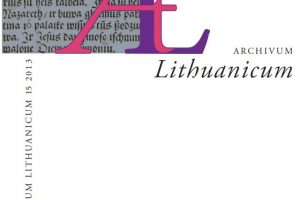Archivum Lithuanicum 14
Prof. habil. dr. GIEDRIUS SUBAČIUS (filologija / philology),
(vyriausiasis redaktorius / editor),
University of Illinois at Chicago,
Lietuvių kalbos institutas, Vilnius
Habil. dr. ONA ALEKNAVIČIENĖ (filologija / philology),
Lietuvių kalbos institutas, Vilnius
Prof. habil. dr. ROMA BONČKUTĖ (filologija / philology),
Klaipėdos universitetas
Prof. dr. PIETRO U. DINI (kalbotyra / linguistics),
Università di Pisa
Prof. habil. dr. JOLANTA GELUMBECKAITĖ (kalbotyra / linguistics),
Johann Wolfgang Goethe-Universität Frankfurt am Main
Dr. REDA GRIŠKAITĖ (istorija / history),
Lietuvos istorijos institutas, Vilnius
Doc. dr. BIRUTĖ KABAŠINSKAITĖ (filologija / philology),
Vilniaus universitetas
Prof. habil. dr. RŪTA MARCINKEVIČIENĖ (filologija / philology),
Vytauto Didžiojo universitetas, Kaunas
Prof. habil. dr. BRONIUS MASKULIŪNAS (filologija / philology),
Šiaulių universitetas
Doc. dr. JURGIS PAKERYS (filologija / philology),
Vilniaus universitetas
Habil. dr. CHRISTIANE SCHILLER (kalbotyra / linguistics),
Humboldt-Universität zu Berlin
Prof. dr. WILLIAM R. SCHMALSTIEG (kalbotyra / linguistics),
Pennsylvania State University, University College
Dr. MINDAUGAS ŠINKŪNAS (kalbotyra / linguistics),
Lietuvių kalbos institutas, Vilnius
Dr. AURELIJA TAMOŠIŪNAITĖ (filologija / philology),
Vytauto Didžiojo universitetas, Kaunas
Dr. BIRUTĖ TRIŠKAITĖ (kalbotyra / linguistics),
Lietuvių kalbos institutas, Vilnius
Dr. JURGITA VENCKIENĖ (filologija / philology),
Lietuvių kalbos institutas, Vilnius
Straipsniai (Articles)
Wolfgang Hock
Untersuchungen zu Daukšas Postille – I. Doppelungen
Lina Plaušinaitytė, Vilma Zubaitienė
Jokūbo Brodovskio žodyno papildymai: kitakilmių žodžių grupė iš Belemnono žodyno (1728)
Birutė Triškaitė
Friedricho Selle’s prierašai rankraštiniame žodyne Clavis Germanico-Lithvana
Giedrius Subačius
Lietuvių kalbos balsių abėcėlės tvarka ir netvarka: istorija ir nūdiena
Jurgita Venckienė
Jono Mačiulio-Maironio raštų rašyba ir kalba: Jauniaus sekėjo dinamika
Nerijus Šepetys
Kalbos norminimas sovietų Lietuvoje: institucijos, ideologija, mokslas
Reda Griškaitė
Emilijos Beniovskytės-Vrublevskienės (Emilia z Beniowskich Wróblewska, 1830-10-05–1886-12-23) dienoraščiai (1850-08-05–1886-09)
Publikacijos (Publications)
William R. Schmalstieg
Jānis Endzelīns’ Letter of March 28, 1960
Recenzijos (Reviews)
Kęstutis Daugirdas
Recenzuojama: Wojciech Kriegseisen, Die Protestanten in Polen-Litauen (1696–1763). Rechtliche Lage, Organisation und Beziehungen zwischen den evangelischen Glaubensgemeinschaften, 2011
William R. Schmalstieg
Review of: Vilma Zubaitienė, Pilypo Ruigio Littauisch-Deutsches und Deutsch-Littauisches Lexicon (1747): Šaltiniai ir leksikografinis metodas, 2010
Anna Helene Feulner
Rezension von: Vilija Gerulaitienė (par.), Teodoras Lepneris, Prūsų lietuvis / Teodor Lepner, Der Preusche Littau, 2011
Christiane Schiller
Rezension von: Liucija Citavičiūtė (par.), Martynas Liudvikas Rėza, Raštai 1, 2011
Birutė Kabašinskaitė
Recenzuojama: Juozas Karaciejus (par.), Contiones Lituanicae. XVIII a. pradžios pamokslai, 2008
Roma Bončkutė
Recenzuojama: Jurgis Ambraziejus Pabrėža, Taislius augyminis I–223, 2009;
Domas Kaunas, Bibliotheca Georgii Comitis de Plater. Jurgio Platerio biblioteka – Lietuvos knygos kultūros ir mokslo paminklas, 2012
Roma Bončkutė, Aurelija Tamošiūnaitė
Recenzuojama: Domas Kaunas ir Audronė Matijošienė (par.), „Auszros“ archyvas. Martyno Jankaus rinkinys, 2011
Aistė Kučinskienė
Recenzuojama: Mikas Vaicekauskas, Motiejaus Valančiaus užrašų ir atsiminimų rankraščiai Lietuvių mokslo draugijoje. 1911–1914 metų istorija, 2009
Darius Staliūnas
Apie kai kurias istorijos mokslo disertacijas, skirtas lietuvių tautiniam judėjimui, apgintas užsienio mokslo įstaigose: Tomo Balkelio (2009) ir Audronės Janužytės (2005) darbai ir jų kontekstas
Diskusijos, apžvalgos, pastabos (Discussions, Surveys, Notes)
Aurelija Tamošiūnaitė
Laiškų duomenų bazės, tekstynai ir duomenynai: užsienio perspektyva
Jürg Fleischer, Florian Sommer
Litauische Materialien im Archiv des Forschungszentrums Deutscher Sprachatlas Marburg
Žavinta Sidabraitė
„Globali Baltija: ateinantys 20 metų“: Baltijos studijų pažangos asociacijos konferencija Čikagoje
Lidia Federica Mazzitelli
The First Berlin Summer School in Lithuanian Studies (Erste Berliner Sommerschule zur Lituanistik) at the Humboldt-Universität zu Berlin, 10.–14. September, 2012
Wolfgang Hock
RESEARCH IN DAUKŠA’S POSTILLE 1: DOPPELUNG
Summary
The German term ‘Doppelung’ refers to the occurence of two (seldom three) semantically equivalent words or phrases in a translated text that correspond to a single word in the source document. Subject of the present article are correspondences of this type between Daukša’s Poſtilla Catholicka (DaP, 1599) and Wujek’s Poſtilla Catholicka Mnieyſza (W³, 1590). The cases in question are collected as completely as possible and analysed linguistically. The linguistic description encompasses formal and semantic aspects such as presence or absence of conjunction, type of conjunction, distribution and the nature of the semantic equivalence. It turns out that the linguistic term ‘synonymy’ is too narrow to cover the whole range of semantic relations between the members of the equivalences in question.
Arguments are provided for the view that this kind of equivalence is neither an exclusive feature of Daukša’s language nor of Old Lithuanian or of translated texts. Rather, it reflects the extensive use of one of the most central Renaissance figures of speech, ‘synonymia’ (also called ‘interpretatio’ or ‘paraphrasis’). The key role of this figure in the 16th century can be traced to the pre-eminence of one textbook, De copia of Erasmus of Rotterdam, which strongly influenced Renaissance education in both Western and Eastern Europe.
Lina Plaušinaitytė, Vilma Zubaitienė
ERGÄNZUNGEN IM WÖRTERBUCH VON JACOB BRODOWSKI (B): EINE FREMDWORTSCHICHT AUS DEM WÖRTERBUCH VON BELEMNON (1728)
Zusammenfassung
Der vorliegende Aufsatz liefert einen Nachweis über die Quelle der in der Ergänzungsschicht des Wörterbuchs von Brodowski angeführten Fremdwörter. Es handelt sich dabei um das Fremdwörterbuch Curiöſes Bauern=LEXICON (1728) (weiterhin Bel), das von einem bisher nicht näher identifizierbaren Autor unter dem Pseudonym Belemnon verfasst wurde.
Aus Bel wurden ins Brodowskische Wörterbuch rund 300 Fremdwörter (die entsprechenden Einträge finden sich bis zur Mitte der Buchstabenstrecke H) samt Bedeutungserklärungen oder deutschen Äquivalenten sowie gelegentlichen Ausspracheangaben übernommen. Auf die Anführung der in den Wörterbuchartikeln von Bel gegebenen Informationen über die verunstalteten Fremdwortformen sowie der Gebrauchsbeispiele dafür hat Brodowski hingegen verzichtet. Allerdings wurden die Lemmata mit Bedeutungserklärungen ausnahmslos übernommen. Einige wenige Auslassungen bzw. Abweichungen von der Quelle sind offenbar unbeabsichtigt gewesen. Nur in seltenen Fällen sind die übernommenen Wörterbuchartikel durch litauische Äquivalente ergänzt.
Die meisten Fremdwortartikel aus Bel befinden sich in B in der für Ergänzungen vorgesehenen Spalte am jeweiligen Seitenrand, wobei ihre Verteilung auf den Seiten wegen der Einhaltung der strikt alphabetischen Anordnung sehr ungleichmäßig ist. Einige Bedeutungserklärungen bzw. Synonyme sind jedoch als Ergänzungen zu den bereits im Haupttext von B vorhandenen Lemmata fremder Herkunft eingetragen.
Die Aufnahme der Fremdwörter ins Wörterbuch von Brodowski zeugt von dem Bestreben des Wörterbuchverfassers, ein universelles und die zeitgenössische sprachliche Situation widerspiegelndes Wörterbuch zu schaffen, welches der häufigen Verwendung des fremdsprachlichen Wortgutes in Büchern und Zeitungen und in der offiziellen sowie Handels- und Privatkorrespondenz Rechnung trägt. Die Fremdwortlisten im Wörterbuch von Brodowski können als ein früher Vorläufer eines litauischen Internationalismen-Wörterbuchs angesehen werden.
Birutė Triškaitė
ZUSÄTZE VON FRIEDRICH SELLE IM HANDSCHRIFTLICHEN WÖRTERBUCH CLAVIS GERMANICO-LITHVANA
Zusammenfassung
Dieser Beitrag behandelt die Frage der Zuschreibung einiger Zusätze im deutsch-litauischen Wörterbuch Clavis Germanico-Lithvana (weiterhin C, nach 1680). Die Zusätze in C stellen die jüngste Textschicht dar. Sie besteht aus Einträgen späterer Wörterbucheigentümer und / oder -nutzer und unterscheidet sich durch Abweichungen bezüglich Handschrift und Tintenfarbe vom Text des Wörterbuchkompilators. Ziel dieses Beitrages ist die Zuschreibung einer kleinen Schicht von Zusätzen, die bisher vorläufig als Hand C bezeichnet wurde, der Hand von Friedrich Selle (1658–1710), Pfarrer der deutschen Gemeinde in Tilsit und Erzpriester des Tilsitschen Sprengels. Zu diesem Zweck wurde die Handschrift der Zusätze mit Autographen von Selle verglichen, die im Geheimen Staatsarchiv Preußischer Kulturbesitz zu Berlin in den Beständen des Preußischen Staatsarchivs in Königsberg gefunden wurden.
Der Feder von Selle können sicher sechs litauische illustrierende Beispielsätze und deren deutsche Entsprechungen zugeordnet werden, die in fünf Wörterbuchartikeln bei den Lemmata Außwendig lernen, Duͤrffen, Gebuͤhren, Kommen und Pflaſter angeführt sind. Bei drei weiteren ergänzten litauischen Äquivalenten ist die Urheberschaft von Selle wahrscheinlich.
In die Hände von Selle ist C vermutlich in Tilsit gelangt. Das Wörterbuch kann Selle, als Erzpriester zu Tilsit und Inspektor der dortigen Provinzialschule, möglicherweise vom Kompilator von C zur Bewertung zur Verfügung gestellt worden sein. Andererseits ist die Möglichkeit nicht auszuschließen, dass Selle das Wörterbuch, genau wie die ehemals dem Kompilator von C gehörende Erstausgabe des Gesangbuches von Daniel Klein Naujos giesmju knygos (Königsberg, 1666) vom Pfarrer von Joneykischken, Georg Heinrich Elbinger, erhalten hat. Unzweifelhaft ist, dass Selles Zusätze zwischen 1687 und 1710 zu datieren sind. Somit war Selle einer der ersten Leser, vielleicht auch Eigentümer der Handschrift.
Giedrius Subačius
ORDER AND DISORDER OF THE VOWELS IN THE LITHUANIAN ALPHABET: A HISTORICAL LOOK AT THE CREATION OF LITHUANIAN ALPHABETICAL ORDER
Summary
1. In the first half of the 19th century the diacritical letters marking vowel sounds were rarely employed in word initial position in the head word in a Lithuanian dictionary, and if occurring, their appearance was quite unsystematic. The authors in Lithuania Major did not use the diacritical ˂Ė˃ at all, although it was present in the dictionary of Kristijonas Milkus (1800) from Lithuania Minor. Dominykas Sutkevičius wrote the diacritical ˂Ą˃ interchangeably with the plain ˂A˃ (1835). Diacritical ˂Į˃ (in the shape of ˂Ɨ˃) was included in the ˂I˃ section both by Milkus and Sutkevičius. Ambraziejus Pabrėža alone separated ˂Ą˃ and ˂Ę˃ under individual headings (in accordance with the alphabetical order of Polish; 1834).
Because of the traditional lack of a distinction between the capital letters ˂I˃ and ˂J˃, the words containing sounds [i] and [j] in word initial position most often were merged into a single list, and the sign ˂I˃ was used to represent both of them (Milkus, Pabrėža, Sutkevičius, and the anonymous author of an Eastern Highland Dictionary). Stanevičius alone (1823) separated sounds [i] and [j] and formed two separate lists for the two distinct letters ˂I˃ and ˂J˃.
According to the practice of many alphabets based on the Latin alphabet, everyone was inserting the Greek ˂Y˃ at the end of the alphabet (in the penultimate or in the adjacent to penultimate position): Milkus, Stanevičius, Pabrėža, Sutkevičius, and the author of the Eastern Highland Dictionary.
Generally, the tendency to maintain the traditional order of the Latin alphabet was obvious: the rarity of diacritical letters in a register, the merger of ˂I˃ and ˂J˃, and the separate status of ˂Y˃ at the end of the alphabet. At the same time, the occasional appearance of diacritical marks reveal a certain novelty absent from Latin: ˂ė, Ɨ˃ by Milkus, ˂Ą, Ɨ˃ by Sutkevičius, and ˂Ą, Ę˃ by Pabrėža.
2. Ferdinand Nesselmann attempted a reform of the alphabet (1851); according to his newly invented order instead of the letters he had arranged the sounds of Lithuanian (for instance, Nesselmann wasn’t allocating any alphabetical position to the “mute” mark of palatalization ˂i˃; it was written but “invisible” for the compiler of a dictionary list). Nesselmann was the first to advance the Greek ˂Y˃ in the alphabetical order and to place it side by side with the letter ˂I˃; he also erased the distinction of alphabetical position between ˂I˃ and ˂Y˃. Nesselmann’s argument was that ˂I˃ and ˂Y˃ in Lithuanian sounded very much alike. And his relocation of ˂Y˃ persists into the modern Lithuanian alphabet.
3. In a few of publications (1856, 1857, 1865) August Schleicher demonstrated his support for the merger of Nesselmann’s ˂I, Y˃ (along with ˂Ɨ˃) and afterwards many followers appeared: Frydrichas Kuršaitis (1883), Vincas Kudirka (1890), Mykolas Miežinis (1894), Jonas Juška (1897), Antanas Lalis (1915), Jonas Jablonskis (1922), Kazimieras Būga (1924), Juozas Balčikonis (1941). Beside the merger of ˂I, Į, Y˃, all of these authors also fused the alphabetical position of diacritical letters for vowels with the plain ones in the groups of ˂A, Ą˃, ˂E, Ę, Ė˃, ˂U, Ų, Ū˃.
4. But not everyone at once accepted such eradication of alphabetical significance for the diacritical letters for vowels and ˂Y˃. In his dictionaries Jurgis Šlapelis (1921, 1938) singled out individual segments under the titles “Ą,” “Ė,“ “Y,” and “Į.” Arndtas Bušas and Theodoras Chomskas (1927) treated those letters analogously, only they put the segment for the Greek ˂Y˃ after the diacritical ˂Į˃. The Dictionary of the International Words (1936) moved the isolated section of the letter ˂Y˃ atypically even further behind ˂J˃. Also a distinct segment for the words with the initial ˂Y˃ was present in The Lithuanian Botanical Dictionary (1938), only elsewhere inside the register the words were alphabetized according to the merged ˂Y˃ value with ˂I˃. All the authors of these works must have been intending to have an alphabet of letters instead of a blend of acoustic and graphic values.
5. During World War II and the Soviet period the order and alphabetical significance of the letters for vowels initiated by Nesselmann were in essence accepted, but their representation on the titles of dictionary segments varied. One tendency was preferred by linguists: to include every single letter in the titles regardless of its presence or absence in the word initial position (aim: codification of the sequence of all the letters) (cf. Orthographical Dictionary of Lithuanian 1948; Contemporary Dictionary of Lithuanian 1954, 1972). Another tendency was to register exclusively the letters really present in the word initial position (The Dictionary of the Botanical Terms 1965; The Dictionary of the International Words 1969). In the edition of Lithuanian Pseudonyms (2004) the compiler Jonas Mačiulis followed both tendencies: the titles in the first volume are minimalistic, and in the second one—quite thorough.
6. Such a comprehensive dictionary as the 20 volume Dictionary of the Lithuanian Language (1956–2002) was the best place to discover the order within the groups of vowel letters ˂A, Ą˃, ˂E, Ę, Ė˃, ˂I, Į, Y˃, ˂U, Ų, Ū˃, even if generally their inner sequence is ignored. Their order became relevant in the words that differ only in letters within one group (the words close to homographs), cf. trèšti, trę̃šti, trė̃šti. It means that the compilers allocated an independent position even to the letters inside a group; as first came ˂a, e, i, u˃, then ˂ą, ę, į, ų˃ were subordinated, and then ˂ė, y, ū˃ followed. Identity of the context activated the inner group differences.
Yet in even more complex cases, where the words close to homographs contained inner group variation not in a single but in two different positions, the compilers of Dictionary of the Lithuanian Language tended to disregard the first variable and to line up the words by the second (rẽtis, rė̃tis, retỹs, rėtỹs were ordered according to the fourth position containing ˂i, y˃ instead of basing the alphabetization on the second position of ˂e, ė˃). The skills needed to identify the cases were not well developed most probably due to the exceptional rarity of such intricate examples even in this ample dictionary.
Three rules can be defined with respect to the need to turn on and off the alphabetical order of vowel letters within the groups: (1) if the words are different (far from being homographs), then the difference inside the groups ˂a, ą˃, ˂e, ę, ė˃, ˂i, į, y˃, ˂u, ų, ū˃ is ignored (the basic rule); (2) if the words are close to homographs, the difference within a concrete group is turned on; (3) if the words are close to homographs and the variation occurs in more than one letter position, the difference inside the first group is turned on and inside the second—ignored.
Today, according to the initial proposal by Nesselmann, the first basic rule treats the letters that mark vowel sounds according to acoustic phonetic features of sounds and not according to any visual graphical attributes of the letters. The alphabetical order of Lithuanian is therefore hybrid: the consonants and plain vowel letters are alphabetized letter by letter, but the diacritical letters for the vowels and ˂Y˃ are alphabetized according to pronunciation.
Instead of disregarding the difference among the letters ˂A, Ą˃, ˂E, Ę, Ė˃, ˂I, Į, Y˃, ˂U, Ų, Ū˃ (as in the first rule), the second and the third rule ignore the similarity of sound sequences [a, a·], [e, e·, e̤·], [i, i·], [u, u·] and deal with the position of concrete letters (i.e., graphic signs). In the rare cases of the identical letter context within different words the Lithuanian alphabet switches to a different mode: for that moment it becomes a homogeneous collection of letters.
Jurgita Venckienė
THE ORTHOGRAPHY AND LANGUAGE OF JONAS MAČIULIS-MAIRONIS’ WRITINGS: THE DYNAMIC OF JAUNIUS’ FOLLOWER
Summary
The first books of Jonas Mačiulis-Maironis were written and published in the last decades of the nineteenth century. At that time standard language norms had not yet been chosen and a few standard language models were competing: (1) that of Kazimieras Jaunius (the Catholic periodicals relied on it); (2) that of secular periodicals; and (3) that of Jonas Basanavičius. The paper discusses the linguistic attitudes of Maironis and their evolution, Maironis’ response to the emerging norms of standard language. The research was based on Maironis’ sermon manuscripts, history books, and poetry publications.
While studying in The Samogitian Theological Seminary in Kaunas, Maironis attended Kazimieras Jaunius’ classes of Lithuanian. Maironis, being an ordinary seminarian, started to follow the model Jaunius delineated in his lectures. Thus, Maironis initially based himself on Jaunius’ ideas of orthography and standardization in period of 1888–1891; his first book Apsakymai apie Lietuvos praeigą (1886 [1891]) attests to this.
Maironis’ written language began to change somewhat as early as 1888. At the time he graduated from the seminary, Maironis stopped using Jaunius’ grapheme ˂iͤ˃ [ie]; he ceased marking ŏ-stem nominal words in iness. sg. and pl. cases; and finally he changed the i-stem nom. pl. However, other features of surviving Maironis’ manuscripts (the sermon and poetry compendium Lietuva) matched those in Apsakymai apie Lietuvos praeigą.
In 1895 publications (Terp skausmu į Garbę and the poetry compendium Pavasario Balsai) Maironis modified: (1) the reflexive infinitive usage; (2) the orthography of nominal words gen. pl.; and (3) cond. 3 of verbs. He began rejecting Jaunius’ forms and orthography earlier than other fellow seminarians. It was periodical press that may have had influence on him. But even with these changes Maironis’ texts remain close to the Catholic clergy model, based on Jaunius’ written standard language school.
Maironis increasingly followed the norms of Catholic and secular periodicals in the early twentieth century. In his scripts he introduced the characters he was earlier avoiding: ˂ū˃, ˂č˃, ˂š˃, ˂uo˃; also, he modified the orthography of nom. pl. of (i̯)ŏ stem nominal words. Thus, increasing influence of periodicals, both Catholic and secular, is evident.
The Orthography of the (1) instr. sg.; (2) nom. pl.; and (3) instr. pl. was altered in 1905. In 1907 Maironis switched to the more consistent way of using the grapheme ˂ū˃ [ū]. Thus, the norms of periodicals prevailed against Jaunius’ model of the written standard language in the later writings of Maironis.
Nerijus Šepetys
LANGUAGE STANDARDIZATION IN SOVIET LITHUANIA: INSTITUTIONS, IDEOLOGY, SCIENCE
Summary
Lithuania has already been an independent state for twenty-two years. Full-scale regulation of the “correctness” of the national language, however, still thrives here. The origins of such a situation may lie in Soviet language policy.
The article presents primary results of archival research. Even though it is officially acclaimed that active standardization of Lithuanian in Soviet era was a secret struggle against Russification for the survival, certain facts can attest this was, at least initially, a product of the planned command economy, initiated or inspired by Moscow. This can be confirmed by the resolutions and work of the State Language Commission, which gradually was gaining power and control.
Unlike in pre-war Lithuania and the West European countries, where language norms are most often conceived as a product of usage, Soviet standardization of Lithuanian gave preference to systematicity of language dominated by scholars. The lingering contemporary approach of the need to centrally control all issues of standardization is an obvious and painful consequence of the Soviet ideology.
Reda Griškaitė
EMILIA WRÓBLEWSKA (1830-10-05–1886-12-23) DIARIES (1850-08-05–1886-09)
Summary
Emilia Wróblewska (or Emilia z Beniowskich Wróblewska) is known mostly as the mother of the famous Vilnius (Rus. Вильна, Pol. Wilno) lawyer and political activist Tadeusz Stanisław Wróblewski (1858–1925). Her name and that of her husband Eustachy Wróblewski (1826–1891) – are immortalized in the name of the library which they founded in Vilnius in 1912, viz. the Eustachy and Emilia Wróblewski Library (originally “Biblioteka im. Eustachego i Emilii Wróblewskich w Wilnie”; now – the Wróblewski Library of the Lithuanian Academy of Sciences; abbreviated here as – LMAVB ). Therefore this woman is usually mentioned only in publications devoted to the library or to her son Tadeusz Stanisław Wróblewski, and more recently to her son Augustyn Wróblewski (1866 – after 1913) in biographical sketches or biographies. Rather more rarely is Wróblewska named as the daughter of Bartłomiej Beniowski (~1800–1867), a participant in the 1830–1831 insurrection or a person with close ties to her husband’s nephew and ward Eustachy Wróblewski, one of the leaders of the 1863–1864 uprising and later with Walery Wróblewski (1836–1908) a general of the Paris Commune. Thus she is mostly mentioned in the context of the men in her life and the library named in her honor. Somewhat more rarely and also rather brief are comments on her pedagogical activity. The purpose of this article is to look more closely at the biography of this woman and her manuscript legacy. There is a good bit of material available for the reconstruction of Wróblewska’s life and creativity and it is now almost all saved in the LMAVB . Her son Tadeusz Stanisław Wróblewski, the founder of the Eustachy and Emilia Wróblewski Library, took care of his mother’s documentary legacy.
Wróblewska’s creative manuscript legacy consists of literary works—translations, poems, summaries of scientific and belles-lettristic books and her personal documentary legacy— diaries, letters, and an album of remembrances. The largest and most valuable is the diaristic legacy consisting of five notebooks (or fragments thereof) of her intimate journal and two journals written for her children. Like Wróblewska’s biography, her diaristic legacy has not been investigated until now. Before this neither gender investigators nor investigators of daily life had paid any attention to this diary. For such persons the fame of the individual is a fact of secondary significance. In scientific literature only fragmentarily is the diary written for her son Tadeusz Stanisław Wróblewski used.
The chronological frame of Wróblewska’s diaries is from 1850 to 1886, thereby reflecting three phases of this woman’s life: youth, maturity, and old age. There are a few digressions from which we can draw some conclusions about her childhood. In all Wróblewska left 730 diary entries, of which three were written in London, 22 in Palanga (Rus. Поланген; Germ. Polangen; Pol. Połąga) and all the rest, viz. 705 in Vilnius. The intensity of the entries reflects the intensity of the author. Therefore most of the entries were made while waiting for the birth of Tadeusz Stanisław Wróblewski in 1858: before her son’s birth (October 27) this woman ‘talked with her diary’ 123 times. Least of all she did this in the last year of her life (only once).
In Wróblewska’s dairy there are few references to purely feminine matters. We find little about the every day intimate aspect—pregnancy and birth. However, there are even fewer reflections of the external world, even of contemporary Vilnius, where she spent all of her conscious life. There is not much information about Palanga, although what she wrote is unique, since she talks about the poorly documented daily life of the resort at that time. On the pages of Wróblewska’s dairy there are not many of the famous people of that time except for the men of her family. Wróblewska’s intimate diary gives the woman’s inner life, oriented to ‘the writing of oneself,’ such that in it predominates the subjective aspect of a woman’s daily life—her emotions, illusions, and personal problems. Therefore even the most important historical events, e.g., the 1863–1864 uprising are portrayed only on an emotional level. It is worthwhile to note that the diaries reflect poorly the well-known biographical facts of the diarist herself, facts known from official documents or reminiscences of contemporaries. The notion that Wróblewska took part in secret instruction is not confirmed. The intimate dairies describe the biography of this woman only on the emotional level.
Diaries written for children make up a specific diary genre. These are so-called external diaries, but that is an expression of the parents’ love and care for their children, showing their mutual personal contact, thus a unique source for the study of family history. Differently from the intimate Wróblewska diary, diaries written for children are more concerned with life style. The longest and most famous was written to her son Tadeusz Stanisław Wróblewski. It would be hard to find another Lithuanian or Polish historical personage of such a rank, whom we could recognize in this manner—through his mother and her diaries. Still from the historical perspective the most important thing in this diarist’s legacy is information about her father Bartłomiej Beniowski, one of the most interesting eccentric personalities of the first half of the 19th century, who left his traces not only in Lithuanian and Polish, but also in English and Irish history.
Wróblewska put herself forward as a representative of the noble class. On the other hand her daily life was connected neither with the live of the village nor the manor, but rather with the city. On the other hand the diarist’s mother, husband and finally her own pedagogical activity obviously connected her with the growing social group—the intelligentsia. All these complicated social changes are felt in this woman’s experiences and her diaries.
For a diary, differently from a letter, unity of themes and intonations is characteristic. The dominant theme of Wróblewska’s diaries is knowing herself, perfecting herself and testing herself in ‘the profession’ of a woman. In the pronouncements of this diarist there are not many signs of women’s emancipation, but it is evident that she constantly stifled and weakened these feelings. Wróblewska was called to science, books, and creativity. Most likely also to pedagogy, although she herself denied it saying that even for her own children she had not worked out any pedagogical system. The biographies of her sons Augustyn Wróblewski and Kazimierz Wróblewski (1872–1890) partially confirm this statement.
According to the generalities of theoretical historians, it is thanks to such sources that men of the past are given the freedom of self expression, they are liberated from the schemes established by historians and one can understand the everyday culture of that period of time from within du dedans. Wróblewska’s diaries, those of a woman living in Vilnius in the 19th century present such a possibility abundantly. Not less important is the aesthetic form allowing one to talk about the double—historical and literary—value of these first-person documents.
12–14 žurnalo tomų leidyba remiama pagal Lietuvos mokslo tarybos remiamą projektą (sut. nr. LIT-2-57) / The publishing of vol. 12–14 was funded by a grant (No. LIT-2-57) from the Research Council of Lithuania.




